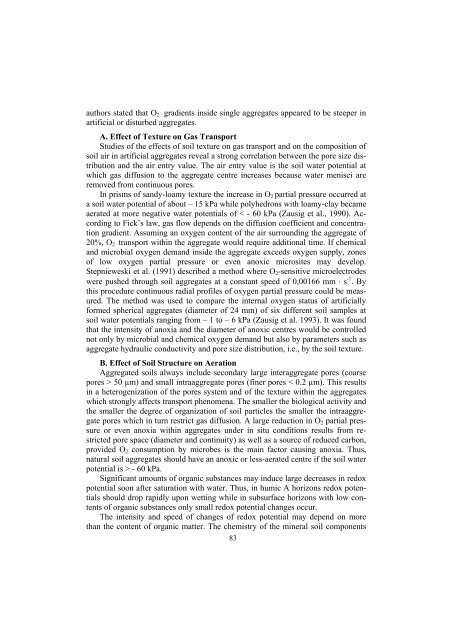soil - Lublin
soil - Lublin
soil - Lublin
You also want an ePaper? Increase the reach of your titles
YUMPU automatically turns print PDFs into web optimized ePapers that Google loves.
authors stated that O 2 gradients inside single aggregates appeared to be steeper in<br />
artificial or disturbed aggregates.<br />
A. Effect of Texture on Gas Transport<br />
Studies of the effects of <strong>soil</strong> texture on gas transport and on the composition of<br />
<strong>soil</strong> air in artificial aggregates reveal a strong correlation between the pore size distribution<br />
and the air entry value. The air entry value is the <strong>soil</strong> water potential at<br />
which gas diffusion to the aggregate centre increases because water menisci are<br />
removed from continuous pores.<br />
In prisms of sandy-loamy texture the increase in O 2 partial pressure occurred at<br />
a <strong>soil</strong> water potential of about – 15 kPa while polyhedrons with loamy-clay became<br />
aerated at more negative water potentials of < - 60 kPa (Zausig et al., 1990). According<br />
to Fick’s law, gas flow depends on the diffusion coefficient and concentration<br />
gradient. Assuming an oxygen content of the air surrounding the aggregate of<br />
20%, O 2 transport within the aggregate would require additional time. If chemical<br />
and microbial oxygen demand inside the aggregate exceeds oxygen supply, zones<br />
of low oxygen partial pressure or even anoxic microsites may develop.<br />
Stepnieweski et al. (1991) described a method where O 2 -sensitive microelectrodes<br />
were pushed through <strong>soil</strong> aggregates at a constant speed of 0,00166 mm ⋅ s -1 . By<br />
this procedure continuous radial profiles of oxygen partial pressure could be measured.<br />
The method was used to compare the internal oxygen status of artificially<br />
formed spherical aggregates (diameter of 24 mm) of six different <strong>soil</strong> samples at<br />
<strong>soil</strong> water potentials ranging from – 1 to – 6 kPa (Zausig et al. 1993). It was found<br />
that the intensity of anoxia and the diameter of anoxic centres would be controlled<br />
not only by microbial and chemical oxygen demand but also by parameters such as<br />
aggregate hydraulic conductivity and pore size distribution, i.e., by the <strong>soil</strong> texture.<br />
B. Effect of Soil Structure on Aeration<br />
Aggregated <strong>soil</strong>s always include secondary large interaggregate pores (coarse<br />
pores > 50 µm) and small intraaggregate pores (finer pores < 0.2 µm). This results<br />
in a heterogenization of the pores system and of the texture within the aggregates<br />
which strongly affects transport phenomena. The smaller the biological activity and<br />
the smaller the degree of organization of <strong>soil</strong> particles the smaller the intraaggregate<br />
pores which in turn restrict gas diffusion. A large reduction in O 2 partial pressure<br />
or even anoxia within aggregates under in situ conditions results from restricted<br />
pore space (diameter and continuity) as well as a source of reduced carbon,<br />
provided O 2 consumption by microbes is the main factor causing anoxia. Thus,<br />
natural <strong>soil</strong> aggregates should have an anoxic or less-aerated centre if the <strong>soil</strong> water<br />
potential is > - 60 kPa.<br />
Significant amounts of organic substances may induce large decreases in redox<br />
potential soon after saturation with water. Thus, in humic A horizons redox potentials<br />
should drop rapidly upon wetting while in subsurface horizons with low contents<br />
of organic substances only small redox potential changes occur.<br />
The intensity and speed of changes of redox potential may depend on more<br />
than the content of organic matter. The chemistry of the mineral <strong>soil</strong> components<br />
83

















